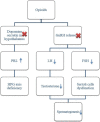Effects of illicit drugs on structural and functional impairment of testis, endocrinal disorders, and molecular alterations of the semen
- PMID: 34712415
- PMCID: PMC8528244
- DOI: 10.22038/ijbms.2021.53326.12002
Effects of illicit drugs on structural and functional impairment of testis, endocrinal disorders, and molecular alterations of the semen
Abstract
Illicit drug use is growing among young people, which is one of the major problems in today's society that can be associated with many medical issues, including infertility. Amphetamines, cocaine, opioids, and marijuana are the most common and the most used illicit drugs worldwide. The purpose of this review was to collect as much literature as possible about the impact of illicit drugs on male fertility and summarize their valuable data. Original studies and reviews were collected by searching the keywords "illicit drugs (all kinds of that) and male infertility". The obtained information was also categorized based on the content of the "Infertility in the Male" book. Almost all studies suggested that taking all kinds of illicit drugs with the effects on different parts of the male reproductive system can result in subfertility or complete infertility in the consumers. Although the data in this field are not decisive and there are some confounding factors in human studies, it can be inferred that the use of any illicit drug with an effect on male sexual health reduces fertility potency. Therefore, it is recommended that couples, who are planning to conceive, avoid taking any illicit drugs before and during treatment.
Keywords: Amphetamines; Cocaine; Illicit drugs; Male infertility; Male reproductive system; Marijuana; Opioids.
Conflict of interest statement
The authors declared no conflict of interest
Figures





References
-
- Jequier AM. Male infertility: A guide for the clinician. John Wiley & Sons; 2008.
-
- Porst H, Montorsi F, Rosen RC, Gaynor L, Grupe S, Alexander J. The premature ejaculation prevalence and attitudes (PEPA) survey: Prevalence, comorbidities, and professional help-seeking. Eur Urol. 2007;51:816–823. - PubMed
-
- Bjorndahl L, Barratt CL, Mortimer D, Jouannet P. ‘How to count sperm properly’: checklist for acceptability of studies based on human semen analysis. Hum Reprod. 2016;31:227–232. - PubMed
Publication types
LinkOut - more resources
Full Text Sources
